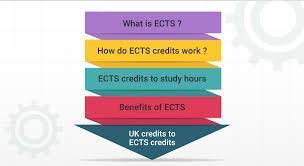



Understanding the credit system abroad is crucial when applying to universities outside your home country. Different countries have different systems for measuring academic progress, and it’s important to be familiar with these systems to understand your academic standing, transfer credits, or compare your academic performance across different countries.
Here’s a breakdown of the most common credit systems abroad, including ECTS (European Credit Transfer and Accumulation System), GPA (Grade Point Average), and others.
The ECTS is the credit system used by most universities in Europe, particularly within the European Union (EU). It is a way of comparing the academic workload and achievements of students across EU countries.
1 ECTS credit = 25 to 30 hours of work (including lectures, seminars, self-study, and exams).
Bachelor’s degree programs usually require 180-240 ECTS credits (3-4 years of study).
Master’s degree programs generally require 60-120 ECTS credits (1-2 years of study).
Doctoral programs don’t typically have ECTS requirements, as they are research-focused.
If you take a full-time study load for a year, you would typically earn 60 ECTS credits in one academic year (this may vary by country or university).
A 3-year bachelor’s degree program would thus be 180 ECTS credits.
The GPA system is commonly used in countries like the United States, Canada, Australia, and some other parts of the world. It is a numerical scale used to measure and represent a student’s academic performance.
The GPA is usually calculated on a 4.0 scale, with 4.0 being the highest (equivalent to an “A” grade).
A weighted GPA takes into account the difficulty of courses (e.g., honors or AP classes may be given extra weight).
4.0 = A (Excellent): 90-100%
3.7 = A- (Very Good)
3.3 = B+ (Good)
3.0 = B (Satisfactory)
2.7 = B- (Fair)
2.0 = C (Passing)
Below 2.0 = Fail (Failing)
Cumulative GPA (CGPA) is the overall GPA that includes all courses taken.
Semester GPA reflects your performance for just one semester.
For example, if you took 5 courses in a semester, your GPA would be an average of the grades you received in those courses. A 4.0 GPA means straight A’s, while a GPA of 3.0 means you’ve received mostly B’s.
In countries like the United States, academic credits are usually measured in credit hours.
A credit hour typically represents one hour of lecture per week for a semester (usually around 15 weeks).
Most courses in the U.S. are worth 3 credit hours.
For example, a 3-credit course may involve 3 hours of lectures per week, with additional time spent on homework, projects, or study.
A full-time student in the U.S. typically takes 12 to 18 credit hours per semester, which translates to about 4-6 courses.
Australia’s academic credit system is similar to the U.S. system, with credit points instead of credit hours. Australian universities also commonly use the GPA scale for grading.
1 credit point usually equals 1 hour of study per week.
Full-time study load for a semester is typically 24 credit points (equivalent to 4 courses).
Bachelor’s degree programs generally require 144 to 192 credit points (typically 3 to 4 years of study).
High Distinction (HD): 85% and above
Distinction (D): 75-84%
Credit (C): 65-74%
Pass (P): 50-64%
Fail (N): Below 50%
The UK system doesn’t generally use credit points in the same way that Europe or the U.S. does, but it does have a similar structure for workload and assessments.
Credits are assigned based on the estimated workload. 1 credit = 10 hours of student work.
Full-time students are expected to take a 120-credit load each academic year (which corresponds to around 30-36 hours of work per week).
Bachelor’s degree typically requires 360 credits (3 years of study) and Master’s degree requires 180 credits (1 year of study).
First Class (1st): 70% and above
Upper Second Class (2:1): 60-69%
Lower Second Class (2:2): 50-59%
Third Class (3rd): 40-49%
Fail: Below 40%
Credit systems in Asia vary by country, but some general principles apply:
In China and India, the academic year is divided into two semesters, and each course typically carries a fixed number of credits.
In Japan, the system is usually based on credits per subject and is similar to Western systems. 1 credit usually equates to 1 hour of class per week, and students are expected to take between 12 and 20 credits per semester.
Grade A: Excellent (above 80%)
Grade B: Good (70-79%)
Grade C: Satisfactory (60-69%)
Grade D: Pass (50-59%)
Grade F: Fail (below 50%)
When applying to study abroad, credit transfer is often an important consideration. Many universities have formal agreements in place for transferring credits between institutions. For example, universities that use the ECTS system may have agreements with universities in the U.S. or Australia to recognize and transfer credits accordingly.
Credit conversion might be necessary if you’re applying to transfer credits from one system to another.
For example, ECTS credits are often converted to U.S. credit hours or GPA by universities when transferring academic records.
Always check with the International Office or Admissions team of the university for specific policies on credit transfer, as each institution may have different rules.
Understanding these different credit systems is essential for navigating the academic landscape abroad. Whether you're considering studying in the U.S., Europe, Australia, or other regions, being aware of how credits, grades, and course loads are structured will help you make informed decisions about your studies, ensure your academic goals are met, and allow you to make smoother transitions between institutions.
If you need further clarification or help with specific credit conversions or requirements, feel free to ask!
#trending #latest

Choose the Best Course Abroad with This Simple Student Guide... Read More.

Life-Changing Benefits of Studying Abroad for Students... Read More.
 Fake posts hit Czech PM Fiala's X
Fake posts hit Czech PM Fiala's X
Fake posts disrupt Czech PM Fiala's X account security
 Switzerland Tightens Export Rules
Switzerland Tightens Export Rules
Switzerland expands export controls on dual-use goods
 Google unveils Ironwood AI chip
Google unveils Ironwood AI chip
Google introduces Ironwood chip to accelerate AI tasks & apps
 TSMC Q1 revenue up 42%
TSMC Q1 revenue up 42%
TSMC sees 42% revenue surge in Q1, surpassing forecasts
 Google unveils Ironwood AI chip
Google unveils Ironwood AI chip
Google's Ironwood chip boosts AI processing and app speed
 Amazon CEO Outlines AI Vision
Amazon CEO Outlines AI Vision
Amazon CEO reveals AI investment plans in new letter
 Osaka Hosts World Expo 2025
Osaka Hosts World Expo 2025
Japan blends tech and culture at Osaka Expo 2025 launch
© MyEduGoal. All Rights Reserved. Design by markaziasolutions.com